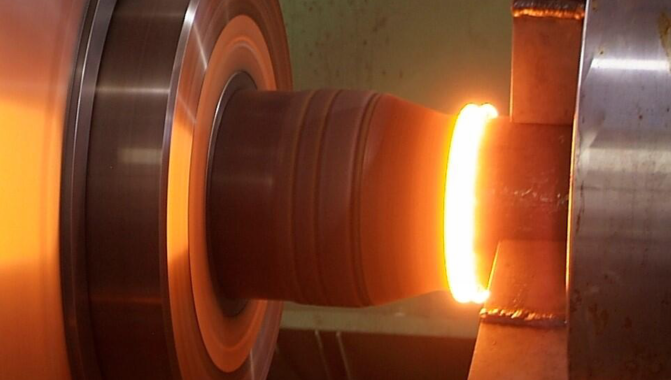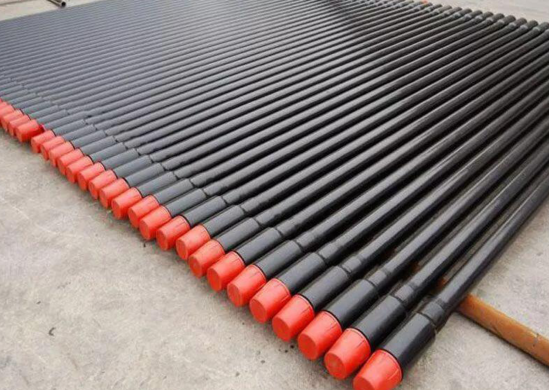Drill pipe plays a vital role in a variety of fields, including mining, geological drilling, and oil and gas exploration. As a core component of the drill string, its performance directly impacts drilling efficiency and safety. The quality and maintenance of drill pipe not only impact field performance but are also closely linked to preventing drilling tool accidents and controlling construction costs. Next, we will delve into the application of friction-welded drill pipe and its on-site maintenance and management strategies.
Currently, the drill pipe bodies widely used in the oil and gas industry primarily include four steel grades: E75, X95, G105, and S135, while tool joints are primarily made of SAE4137H. These drill pipe bodies have outer diameters ranging from 2 3/8" to 6 5/8", offering a wide variety of specifications.

Generally speaking, higher steel grades increase drill pipe's strength and load-bearing capacity. However, when selecting drill pipe, we shouldn't simply pursue the highest strength. In drilling fluid environments, the corrosion fatigue resistance of drill pipe decreases with increasing steel grade. In other words, high-grade steel drill pipe is more sensitive to corrosive media in corrosive environments, resulting in a greater decrease in corrosion fatigue strength and a greater susceptibility to corrosion fatigue fracture.
Therefore, when selecting drill pipe, we should adhere to the principle of "preferring lower-grade steel drill pipe, provided it meets strength requirements." We should also select the most suitable drilling tools for the drilling operation, taking into account actual site conditions. This not only helps reduce drill pipe procurement costs but also effectively minimizes the likelihood of accidents.
Overall Structure of Friction-Welded Drill Pipe:
Friction-welded drill pipe uses friction welding technology to tightly connect the internal and external threaded joints to the drill pipe body, forming a coherent whole. During drilling, the drill pipe is driven by a rotary table or power unit, continuously rotating to effectively transmit power to the drill bit at the bottom of the hole. The drill pipe also fulfills the crucial task of transporting drilling fluid to the cutting face of the drill bit, playing an indispensable role in the entire drilling operation.
Currently, domestic drill pipe manufacturers primarily adhere to two standards for friction-welded drill pipe production: the SY/T 5114-2014 Petroleum and Natural Gas Industry Standard of the People's Republic of China, and the internationally recognized API 5DP Drill Pipe Specification for the American Petroleum Institute. Both standards provide detailed specifications for the parameters and performance indicators of key components such as the drill pipe body, joints, and friction weld zones, providing an important reference for drill pipe selection and quality assessment.
Drilling Tools Use and Management at Construction Sites
1. Preparing Drill Pipe Before Lowering
Before use, drill pipe must be neatly arranged in a flexible drill pipe rack at least 0.3 meters above the ground, according to specific specifications. The rack must be stable and level to prevent bending and deformation. Drill pipe at both ends of the rack must be secured with chocks to prevent rolling or falling.

2. Inspection and Protection Before Going to the Drill Floor
Before going to the drill floor, be sure to thoroughly clean and inspect the threads and shoulder sealing surfaces of the drill pipe joints to confirm they are intact. When hoisting drill pipe, wear a thread protector (steel is recommended) to protect the threads and shoulder surfaces from damage.
3. Hanging and Applying Special Thread Compound
When hoisting the drill pipe along the slideway, the winch should maintain a steady speed. Just as the drill pipe is about to leave the slideway, it should be lightly stopped with a soft rope to prevent collisions. Before connecting the drill pipe at the wellhead, clean and inspect the joint threads and shoulder sealing surfaces again. Once confirmed, apply a generous amount of special oil drilling tool thread compound containing 60% fine metallic lead powder or 40-60% fine metallic zinc powder, ensuring an even application. Care should be taken to prevent foreign matter such as sand from entering the thread compound, as this may affect its performance or scratch the threads and shoulder sealing surfaces.
Key Points in Drill Pipe Use:
When new drill pipe is first put into service, it should be unscrewed twice at the wellhead using a torque slightly lower than the standard value to verify the integrity of the joint threads and sealing surfaces. After confirming that everything is correct, apply a generous and even amount of thread compound as specified, tighten the joint threads, and then run the pipe downhole. This run-in process helps increase the surface hardness of the threads and improve galling resistance, thereby extending the service life of the drill pipe.
When connecting drill pipe at the wellhead, manually straighten and guide the joint to avoid impact damage to the end faces or threads of the male and female connectors. Then, manually verify the joint using chain pliers, ensuring at least two threads have been introduced. Then, tighten the drill pipe joint threads to the specified torque using hydraulic power tongs. Please note that the required make-up torque varies for drill pipe of different steel grades, specifications, and waterhole sizes, so careful differentiation is essential.
In addition, the breakout drill pipe string should be rotated before each trip to ensure that each pair of joints has been made and broken out during three trips. This not only facilitates timely inspection of each joint thread but also effectively reduces galling, stripping, and puncture problems. At the same time, regular rotation of the upper and lower drill string positions is essential. This can change the stress distribution within the drill string, ensuring more balanced forces across the entire assembly, thereby extending its service life and reducing premature failures.
During drilling, the appropriate rotational speed and weight on bit (WOB) must be carefully selected based on the formation characteristics, wellbore size, and lower drill string configuration to ensure optimal drilling performance and achieve efficient drilling results. It is important to note that when the drill string reaches its critical rotational speed, the longitudinal, lateral, and torsional vibration frequencies generated by the rotation coincide with the drill string's natural frequency, potentially inducing resonance. Once resonance occurs, the entire drill string in the hole becomes severely unstable, subjecting it to additional fatigue stress and accelerating fatigue failure of the drill string. Furthermore, excessive WOB increases the resistance experienced by the bottomhole drill bit, which can easily lead to stuck drill bits. When the applied WOB exceeds the critical WOB, the drill string may bend, resulting in serious consequences such as well inclination and fatigue fracture of the lower drill string threads.
When operating in a corrosive environment, measures such as adding deoxidizers and corrosion inhibitors to the drilling fluid, raising the pH of the drilling fluid to above 10, selecting drill pipe with sulfur resistance, using internally coated drill pipe, and, provided strength requirements are met, prioritizing lower-grade steel.
When disassembling threads at the wellhead, first use a low gear and ensure that the hook spring maintains a certain tension to prevent pressure on the threaded surfaces of the two joints. Once the joint threads are completely disengaged, lift the hook to avoid damaging the threads and ensure that the spring force of the upper drill pipe does not impact or collide with the female connector at the wellhead.
Post-use Maintenance of Drill Pipe:
After drilling, drill pipe should be organized according to specification, wall thickness, water hole size, steel grade, and classification. Afterwards, thoroughly clean the interior and exterior surfaces of the drill pipe, including the joint threads and shoulder sealing surfaces, to ensure no residue remains. During the inspection, attention should be paid to the drill pipe surface for cracks and nicks, the integrity of the threads, any uneven wear on the joints, a flat and free-from abrasions on the shoulder surface, and any bends or bites on the pipe body. Furthermore, the internal and external surfaces of the drill pipe should be inspected for defects such as corrosion and pitting. If conditions permit, ultrasonic testing of the drill pipe body and magnetic particle testing of the threads are recommended to prevent failures such as joint thread breakage and drill pipe body leaks. For drill tools without defects, apply anti-rust oil and use thread protectors as protective measures.
On site, defective drill pipe should be marked with paint and stored separately to prevent misuse. Problem drill pipe should also be promptly repaired or replaced to ensure smooth subsequent construction. Drill pipe stored outdoors for long periods should be covered with rainproof tarpaulin and regularly inspected for corrosion on the internal and external surfaces to prevent moisture and corrosion.
Read more: Drill Pipe Connection Method or Difference between Casing pipe and Drill pipe



